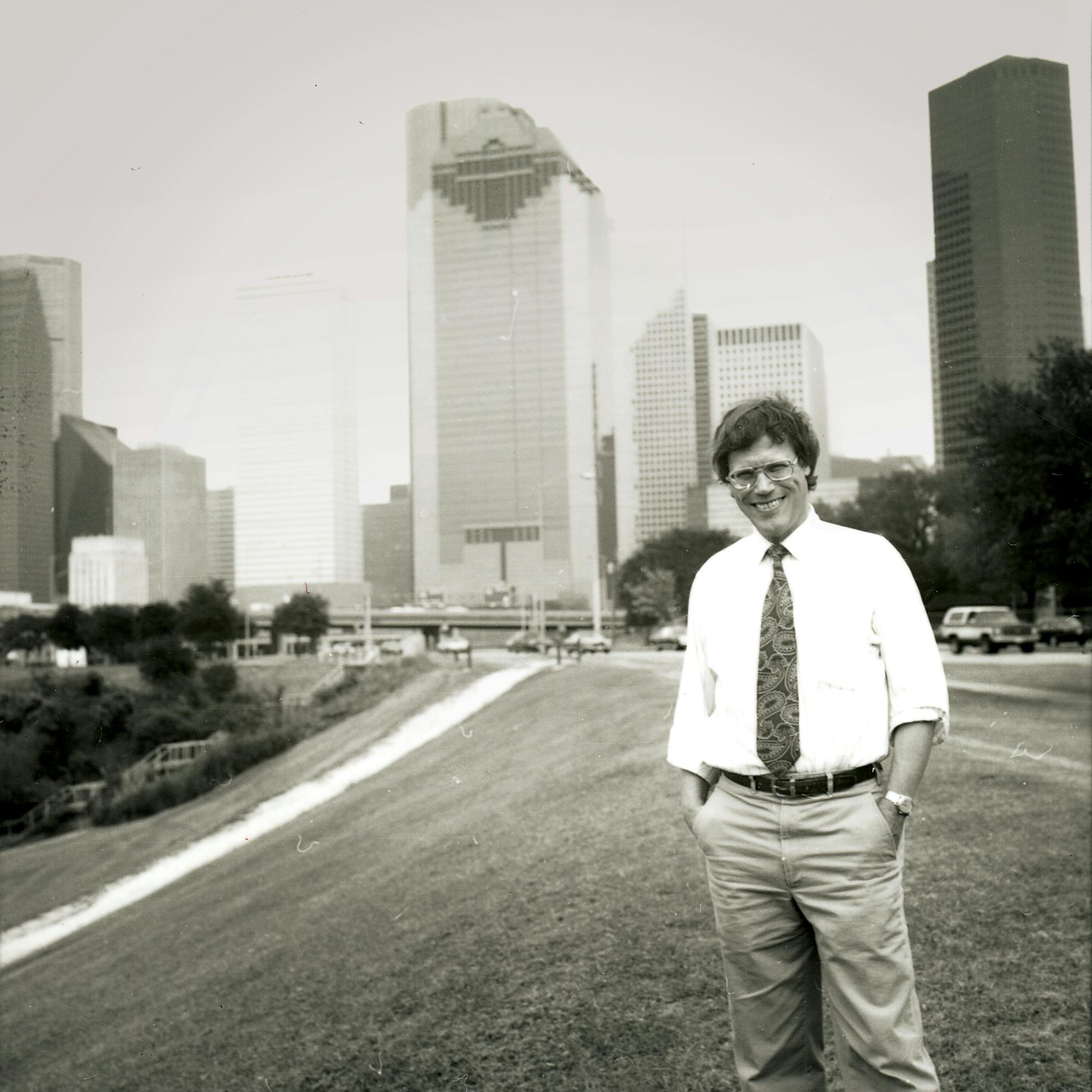Featured in the Houston City Guide
Discover the best things to eat, drink, and do in Houston with our expertly curated city guides. Explore the Houston City Guide
One of the side effects of living in a city that runs on oil and gas is that time feels cyclical. Instead of progressing from the past to the future, life in Houston has historically alternated between boom and bust. It’s as if the city runs on some Mayan calendar that repeats itself over and over as—according to one controversial interpretation—it counts down to the apocalypse.
Stephen Klineberg’s new book Prophetic City: Houston on the Cusp of a Changing America (Avid Reader Press) breaks that wheel. The longtime Rice University sociologist has crafted a linear narrative—a march of demographic trends that points forward rather than simply bouncing between economic poles. Houston’s older Anglos, the data shows, are being succeeded by a younger, more diverse cohort with different views, values, and economic needs than their predecessors’. The majority of Harris County residents under the age of twenty are Latino. Only a fifth are white. The problems and opportunities the region deals with today are a glimpse into our increasingly multiracial nation’s future. Rather than being a city of oil and gas, Klineberg argues, Houston is a city of prophecies.
All too often nonfiction books about Houston use the city simply as the incidental setting for some scintillating tale of industrial hubris, natural disaster, or NASA spectacle. Think of Bryan Burrough’s The Big Rich, in which Houston is a mere playground for oil titans like Hugh Roy Cullen and Glenn McCarthy. Or the litany of Enron books that document how Ken Lay, Jeff Skilling, and Andrew Fastow made Houstonians their collective victims in a massive case of corporate fraud. Or Jim Lovell and Jeffrey Kluger’s Lost Moon, the basis of the movie Apollo 13, which cast Houston as the city that astronauts call when they have a problem. In these tellings, Houston is the place where outlandish stories just happen to take place. Portrayed as having little character of its own, it’s an exotic-enough setting for non-Texas readers, but it might as well be San Diego or Atlanta. So it’s a relief to read a book where Houston isn’t just the backdrop—it’s the story.
Klineberg, a native New Yorker who arrived in Houston in 1972, built this story from decades of close study of his adopted hometown. For the past 38 years, he has conducted Rice’s Kinder Houston Area Survey, a telephone poll of the opinions and perspectives of hundreds of locals that was created by him and a group of graduate students. What began as a onetime effort is now a core function of Rice’s Kinder Institute for Urban Research. No other American city has anything on its scale.
In Prophetic City, Klineberg combines this research with personal narrative and a concise history of Houston, making it critical reading for anyone interested in the Bayou City. The thesis, Houston’s diversity, isn’t new—Klineberg repeats it every year when he releases the annual survey—but it’s presented here in a richer context. The book, released just as Klineberg turns eighty, is a grand summation of his decades-long project, intertwining slices of data, interviews with prominent citizens, and prosaic vignettes that offer a vision of Houston as seen through the professor’s eyes. (I almost expected to read about a lunch he and I had years ago, when I was a Houston Chronicle staffer, at a strip-mall Indian-Pakistani restaurant.)

Though a handful of books have delved into specific aspects of Houston’s growth, the most recent comprehensive account was David McComb’s Houston: A History, which was published in 1981, not long before the historic oil bust kneecapped the local economy. Prophetic City picks up where McComb left off, documenting Houston from its oil bust nadir to its recent peak.
To Klineberg, Houston transcends the refineries and oil fields. More-mundane events and locales—naturalization ceremonies, business luncheons, Chinatown strip malls—are the heart of the city. As he points out often, Houston is now a city of conveners, not kingmakers. (He borrowed that line from Mustafa Tameez, a well-respected local politico and first-generation immigrant—a.k.a. a real Houstonian.) The wealthy pooh-bahs who once pulled the political and economic strings from Suite 8F of the Lamar Hotel have been replaced by a spectrum of partnerships, nonprofits, and community organizations. Plenty of Houstonians may have a chip on their shoulder about living in a place maligned by architects and urbanists as the anti-city for its endless sprawl and lack of zoning, but Klineberg reframes that narrative. Houston isn’t about the place—it’s about the people. Consider it appropriate that a sociologist has emerged as the city’s scribe.
Houston’s grand achievement, as Klineberg tells it, is that we’re the blue-collar city that succeeded where the rust belt failed. The first Houston Area Survey was conducted in 1982, just before the bust. It showed that 76 percent of respondents rated job opportunities as “good” or “excellent.” In the second survey, the following year, only 40 percent still felt that way. Houston seemed primed to go down the same dark road to economic perdition as other once-great American cities that saw their population and economic footprint decline after their core industries peaked.
And yet it was this bust—not the booms that bookend it—that turned Houston into the city we recognize today. That’s because Houston didn’t shrink. It kept growing. This growth wasn’t driven by the largely Anglo residents who made up the majority of the city’s inhabitants. In fact, the Anglo population started to decline into the nineties. This growth was driven by immigrants.
There are a few reasons the city drew so many new Americans. First, the federal government designated Houston a resettlement area for Southeast Asian refugees fleeing the fall of Saigon. Then came Central Americans fleeing political turmoil, and then people from Cuba, Iraq, the Democratic Republic of the Congo, and Somalia. Many Hispanic immigrants also moved to Houston through family reunification or as undocumented laborers. Hispanic Texans from the Valley ventured north to Houston as well. Greeted by nonprofits trying to do good, business interests desperate for commerce of any kind, and landlords and realtors overloaded with inexpensive housing, all of these groups found oil-bust Houston appealing. And so did highly educated immigrants from Asia, Africa, and Latin America who came to start careers with the Texas Medical Center, NASA, and the petrochemical industries that were taking advantage of cheap crude.
Without all of these newcomers, Klineberg told me in late March, “we would have had the same fate as other major American cities that are losing their status as major cities because they stopped growing: Philadelphia, Baltimore, Pittsburgh, St. Louis, Detroit.” Instead, we ended up among the ranks of Los Angeles and New York and London.

Monkey See, Monkey Due
Stephen Klineberg on Houston’s eighties oil boom: “It was so easy to find well-paid work and high profits in those days that people used to say you could dress a gorilla in a business suit, send him downtown, and he’d become a millionaire in a week!”
Throughout the book, Klineberg himself comes off as the quintessential Houstonian, someone who arrived here from somewhere else and then made the city his own. He’s friendly, always working, and persistently bullish about the city—an optimism that has remained a consistent characteristic of Houstonians in Klineberg’s surveys over the years.
Don’t be mistaken—he’s not naive. Klineberg doesn’t gloss over the challenges facing Houston. He hammers home that though the city is diverse, it remains economically segregated. Pollution is excessive. Flooding is a constant danger. Local government often fails to provide basic services for people who need them the most, and politicians rely on private philanthropies to help fill the gaps. At one point former county judge Ed Emmett tells Klineberg that Houston isn’t a prophetic city but a “pathetic” city.
Meanwhile, though the economy has diversified, the oil and gas sector still serves as the core engine for Houston’s economy. The current oil bust, helped along by the coronavirus pandemic, threatens to put the city back on that apocalyptic calendar.
More than anything, Houston will have to improve its education system if it wants to remain competitive in the twenty-first century. “[The priority] isn’t dredging the Ship Channel anymore,” Klineberg told me. “It’s investing in preschool education that will pay off twenty years into the future.”
Houston hasn’t done that, perhaps because education has never been all that critical to Houston’s economic success. Blue-collar jobs in the oil industry have long delivered a middle-class lifestyle to someone with a high school education. And when Houston firms did need someone with a geology degree, they could always hire them from Rice or import them from the University of Texas at Austin, Texas A&M University, or out of state.
Because Houston has never prioritized education, our political leadership lacks the muscle memory to take substantive action. A 2013 effort to raise property taxes for Early to Rise, a universal pre-K program, was removed from the ballot due to a technicality. In 2018 Mayor Sylvester Turner’s plan to rescue failing schools with a public-private partnership flopped before it even started. A dysfunctional Houston Independent School District board of trustees is fighting a state takeover.
The private sector isn’t doing much better. The donor class that made its fortunes in Houston has paid it back with transformative contributions to museums and parks, but playing a role in education beyond the city’s universities is a relatively new phenomenon. Klineberg notes that local boosters during the eighties bust offered everything from free opera tickets to mortgage refinancing lessons to help the city survive, yet none of those efforts addressed the city’s public school system. And despite contemporary support for charter schools, private schools, and, to a certain extent, even HISD itself—the recently renamed Kinder High School for the Performing and Visual Arts is a prime example—fixing Houston’s education system will require a larger, systemic investment.
There’s no denying that philanthropies play a critical and beneficial role in Houston—I should know, I work at one. But as Klineberg attests, the sad fact is that most public school students have been left behind, and UH and Rice will need a lot more help if they want to compete with world-class institutions of higher education in and around San Francisco, New York, and Boston. Heck, Houston can’t match San Antonio when it comes to pre-K.
Klineberg is admirably tough-minded about the city’s failure to educate its children. “In a city with at least thirteen billionaires and private foundations with some of America’s largest endowments, Houston’s public schools are filled with a majority of children in poverty who will graduate without the skills needed to succeed,” he writes.
Those are sharp words. But, frustratingly, Klineberg tees this argument up and then never takes a full swing. The reader waits for him to name names, grab some local leaders by their figurative lapels, and demand the effort it would take to set the city’s educational system on the right track. Because whatever they’re doing now, it isn’t enough.
In the end, the usually excitable Klineberg sounds almost melancholic. The next generation of Houstonians is going to be more diverse, more tolerant, and more welcoming than any that came before—but what good is that if all but a lucky few end up poor?
Houston is changing. Houston is the nation’s demographic future. Klineberg makes that much clear. Whether that future will be as prosperous as the past is a question his surveys can’t answer.
Evan Mintz lives in Houston and was a 2017 Pulitzer Prize finalist for editorial writing.
- More About:
- Books
- Rice University
- Houston






